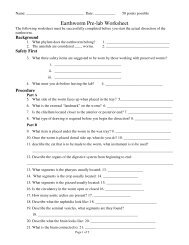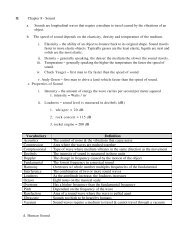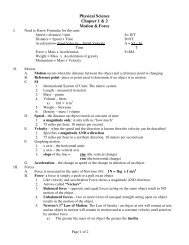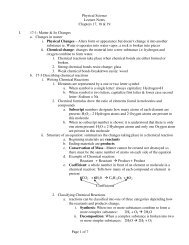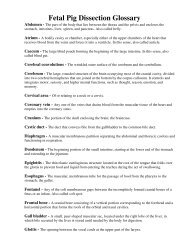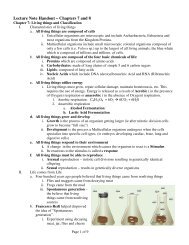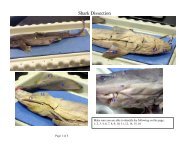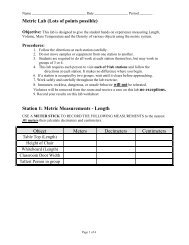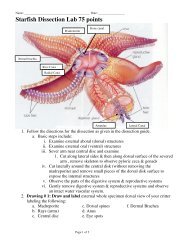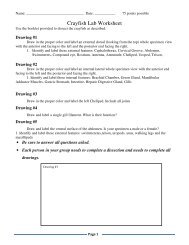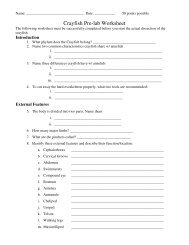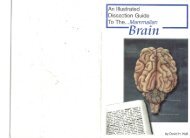Physical Science Lecture Notes Chapters 8, 9, 10 & 11 - Mr.E Science
Physical Science Lecture Notes Chapters 8, 9, 10 & 11 - Mr.E Science
Physical Science Lecture Notes Chapters 8, 9, 10 & 11 - Mr.E Science
Create successful ePaper yourself
Turn your PDF publications into a flip-book with our unique Google optimized e-Paper software.
<strong>Physical</strong> <strong>Science</strong><br />
<strong>Lecture</strong> <strong>Notes</strong><br />
<strong>Chapters</strong> 8, 9, <strong>10</strong> & <strong>11</strong><br />
I. Chapter 8 - Sound<br />
a. Sounds are longitudinal waves that require a medium to travel caused by the vibrations of<br />
an object.<br />
b. The speed of sound depends on the elasticity, density and temperature of the medium.<br />
i. Elasticity – the ability of an object to bounce back to its original shape. Sound<br />
travels faster in more elastic objects. Typically gasses are the least elastic, liquids<br />
are next and solids are the most elastic.<br />
ii. Density – generally speaking, the denser the medium the slower the sound travels.<br />
iii. Temperature – generally speaking the higher the temperature the faster the speed of<br />
sound.<br />
iv. Chuck Yeager – first man to fly faster than the speed of sound<br />
v. Andy Green – first man to drive a land vehicle faster than the speed of sound.<br />
c. Properties of Sound<br />
i. Intensity – the amount of energy the wave carries per second per meter squared<br />
1. intensity = Watts / m2<br />
ii. Loudness – sound level is measured in decibels (dB)<br />
1. whisper = 20 dB<br />
2. rock concert = <strong>11</strong>5 dB<br />
3. rocket engine = 200 dB<br />
d. Human Sound<br />
a. Converting sound waves (vibrations) into sensory impulses interpreted as<br />
sound.<br />
b. Three parts to your ear: Outer Ear, Middle Ear and Inner Ear<br />
i. Outer Ear: The funnel shaped ear flap (pinna) and the auditory<br />
canal direct sound to the eardrum (tympanum) which separate the<br />
outer and middle ear<br />
ii. Middle Ear: The sound waves vibrate the tympanum which causes<br />
the three smallest bones in the body to also vibrate. These bones (in<br />
order) are the Hammer (Malleus), Anvil (Incus) and Stirrup<br />
Page 1 of 8
iii.<br />
(Stapes). The end of the stirrup vibrates a thin membrane, the Oval<br />
Window, covering the inner ear. The Eustachian tube connects the<br />
middle Ear with the back of the throat (Pharynx) to allow<br />
atmospheric pressures to equalize on each side of the tympanum.<br />
Inner Ear: The Oval Window separates the middle and inner<br />
ears. This membrane touches the fluid filled chamber of the<br />
cochlea causes the Cochlea to vibrate. The inner surface of the<br />
cochlea is lined with tiny nerve receptor Hair Cells. These<br />
receptors stimulate the neurons of the auditory nerve<br />
(Vestibulocochlear Nerve) which carries impulses to the<br />
cerebrum where it is interpreted as sound.<br />
I. Chapter 9 Section 1 – The Nature of Electromagnetic Waves<br />
A. EMR requires no medium to travel- can travel thru a vacuum<br />
B. Consists of changing electric and magnetic fields<br />
1. Electric field is a region where particles can be pushed or pulled.<br />
a. Wherever there is an electric charge there is an electric field associated w/<br />
it.<br />
b. A moving electric charge is part of an electric current<br />
c. An electric current is surrounded by a magnetic field<br />
2. A magnetic field is a region in which magnetic forces are present<br />
3. When electric field changes – so does the magnetic field.<br />
a. When one vibrates--- so does the other<br />
C. Speed<br />
1. 300,000,000 meters /sec<br />
2. 186,000 miles /sec<br />
D. Wave or particle?<br />
1. Acts like a wave when passing thru a polarizing filter<br />
Page 2 of 8
2. Acts like a particle – photoelectric effect<br />
E. Waves of the EMS<br />
R O Y G B I V<br />
II. Chapter <strong>10</strong> Section 1 – Reflection & Mirrors<br />
Page 3 of 8
A. When light strikes an object<br />
1. It is either reflected, absorbed or transmitted.<br />
a. Opaque: a material that reflects or absorbs the light – can’t see through it. -<br />
wood<br />
b. Transparent: The material transmits light – allows light to pass through it<br />
– glass<br />
c. Translucent: allows some light to pass through – can’t see image clearly –<br />
wax paper, frosted glass.<br />
B. Kinds of Reflection<br />
1. You see objects because light is reflected, bounced off of it.<br />
2. Law of Reflection: Angle of reflection equals the angle of incidence –<br />
a. Angle coming in = angle going off<br />
3. Regular Reflection: reflection off smooth surface – a mirror<br />
4. Diffuse Reflection: Irregular or bumpy, uneven surface – wall<br />
C. Mirrors<br />
1. Image: a copy of an object formed by reflected or refracted light<br />
a. a virtual image: (right side up, can see it but its not really there) appears to<br />
be coming from behind the mirror.<br />
b. Real Image: is formed when reflected light rays actually meet at a point.<br />
The image is upside down (inverted),<br />
2. Plane Mirror: a flat mirror – produces an image that is right side up and the same<br />
size as the original object –<br />
3. Concave Mirrors: a mirror with a surface curved inward like a “cave” or a bowl.<br />
a. Light reflected comes together to meet at a Focal Point.<br />
b. Can produce virtual or real images<br />
c. Produces magnified images<br />
4. Convex Mirrors:<br />
a. A mirror w/ a curved surface facing outward<br />
b. Reflected rays appear to come from a focal point behind<br />
the mirror<br />
c. Images formed are always Virtual<br />
III. Section 2 – Refraction and Lenses<br />
A. Refraction of Light: Bend or change direction<br />
1. As light rays enter a new medium the cause light to bend<br />
2. The denser the medium – the slower the light travels<br />
3. Index of Refraction: a measure of how much a medium bends the light that travels<br />
through it.<br />
4. Prisms: Separates white light into its component colors.<br />
a. The longer the wavelength, the less it will be bent by the prism.<br />
5. Rainbows- light shining thru tiny droplets of water, each droplet acts as a prism<br />
6. Mirage- is an image of a distant object caused by refraction of the light. Light<br />
travels faster in the warmer air causing light rays to bend<br />
B. Lenses – a curved piece of material used to bend light<br />
1. Concave lenses: as light passes through, they are bent away from the center<br />
a. Images produced are only virtual, not real<br />
2. Convex lenses: cause light passing through to bend toward the focal point.<br />
a. The images produced depends on the position of the object<br />
IV. Section 3 – Color<br />
Convex side<br />
Concave side<br />
Page 4 of 8
A. The color of the object you see is the light that is reflected from its surface. All other colors<br />
are absorbed by the object.<br />
1. Objects in white light – the color you see is due to the object absorbing all of the<br />
visible light EXCEPT the color you see. That color reflects off the object and goes<br />
into our eyes<br />
B. Combing colors<br />
1. The 3 colors of light that can combine to form all other colors are primary colors –<br />
a. Red, Blue, Green<br />
i. Equal Red + Equal Blue = Magenta (secondary color)<br />
ii. Equal Red + Equal Green = Yellow (secondary color)<br />
iii. Equal Green + Equal Blue = Cyan (secondary color)<br />
iv. Equal Red + Equal Green + Equal Blue = White<br />
2. Any 2 colors that combine to form white are complementary colors<br />
a. Secondary color + remaining Primary Color = White<br />
b. Magenta + Green = white<br />
c. Cyan + red = white<br />
d. Yellow + blue = white<br />
3. Pigment – substance that color other materials like paints, inks, etc<br />
a. Primary Pigments are Cyan, Yellow & Magenta<br />
b. Cyan + Yellow + Magenta = Black<br />
c. Cyan + Yellow = Red<br />
d. Yellow + Magenta = Red<br />
e. Cyan + Magenta = Blue<br />
f. The primary pigments are the secondary light colors!<br />
4. Three primary colors = three secondary pigments<br />
5. Three primary pigments = Three secondary colors<br />
V. Seeing Color - Eye Sight<br />
Page 5 of 8
a) Light passes thru a transparent cornea which begins to focus it, next to the fluid filled<br />
space called the aqueous humor, thru the major focusing structure, the lens. The lens is<br />
held in place by ligaments attached to ciliary muscles (aka. ciliary body). These<br />
muscles contract and<br />
change the shape of the lens<br />
which changes the focal<br />
point. The Iris is the color<br />
part of the eye and<br />
regulates how much light is<br />
allowed into the eye<br />
through the pupil. The light<br />
then passes thru a fluid<br />
(vitreous humor) and<br />
focuses on the back of the<br />
eye, the retina. The central<br />
region where images<br />
focused is the fovea. Light<br />
sensitive structures detect<br />
light/dark and movement<br />
are the rods ( about 1<br />
billion). Color is detected<br />
by cones (about 3 million). The impulses generated by the rods & cones are<br />
transmitted to the brain via the optic nerve. The large white ball of the eye is the<br />
Sclera<br />
b) Nearsighted: Ability to see “near” items where far items are out of focus – caused by<br />
focal point in front of the retina<br />
c) Farsighted: Ability to see “far” items whereas near items are out of focus – caused by<br />
focal point of the lens being beyond the retina<br />
VI. Chapter <strong>11</strong> – Magnetism and Electromagnetism<br />
A. Magnets<br />
1. A special stone first discovered
C. Magnetic Fields – that region around a magnet that is<br />
affected by the magnet. Strongest at the poles, the Force<br />
forms lines that go out of the North Pole and wrap back<br />
around to enter in at the South Pole.<br />
D. Magnets attract because force comes out of North Pole<br />
and goes into the South Pole<br />
E. Magnets repel because the forces are pushing away from<br />
each other<br />
F. Inside a magnet<br />
1. At the atomic level, there are protons (+ charge) & neutrons (neutral charge) in<br />
the nucleus, and electrons (- charge) spinning in orbits around the nucleus. The<br />
moving electron acts as a mini electrical charge and therefore has a magnetic field<br />
associated w/ it.<br />
2. In ferrous materials clusters of atoms align there atoms<br />
w/ one another. A cluster of billions of atoms w/<br />
magnetic fields aligned is called a domain.<br />
3. When domains are randomly arranged – forces cancel<br />
each other out. – no net magnetic affect<br />
4. When domains have their magnetic affect in alignment -<br />
– forces are additive and create a strong magnetic affect<br />
G. Making Magnets<br />
1. Since Magnetism and electricity are so closely related,<br />
it is relatively easy to make magnets<br />
2. Temporary magnets – materials that become magnetized while in contact w/<br />
strong magnets – ie a paperclip is able to pick up more paper clips when stuck to a<br />
strong magnet<br />
3. Permanent magnets – materials that maintain their magnetism when the magnet is<br />
removed from it.<br />
H. Destroying & Breaking magnets –<br />
1. Magnets that are dropped, or struck hard will cause the domains to misalign.<br />
2. Heating also causes the atoms to vibrate faster and faster allowing the domains to<br />
misalign.<br />
I. Magnetic Earth<br />
Page 7 of 8
1. Earth’s core is Iron – Earth is a giant magnet<br />
2. Earth’s magnetic north pole is not the same as Earth’s axis north pole. It is about<br />
1250 km (776 miles) away from the true north pole<br />
3. The angle between true north and magnetic north is the magnetic declination.<br />
Diagram showing the magnetic<br />
force field surrounding the<br />
Earth. The Solar Wind<br />
compresses the force field on<br />
the Sun side and is deflected by<br />
the force field know as the<br />
Magnetosphere<br />
J. Electric Current & Magnetic Fields<br />
1. When electric charges run thru a wire they create an electric current – a flow of<br />
charge thru a material<br />
2. An electric current produces a magnetic field<br />
3. Electric circuit – a complete path through which electric charges can flow<br />
a. Each circuit has a source of electrical energy<br />
b. Have devices that are run by the electric current<br />
c. Connected by conducting wires and a switch<br />
4. Conductors & Insulators<br />
a. Conductors allow current to flow easily<br />
i. Their electrons are loosely bound to their atoms<br />
ii. Metals – copper, silver, iron, superconductors<br />
b. Insulator – do not allow current to flow easily<br />
i. Electrons are tightly bound to atom<br />
ii. Plastic, wood, rubber, sand, glass<br />
5. Electrical Resistance – a substance that utilizes electrical energy as it interferes w/,<br />
resists<br />
Page 8 of 8



